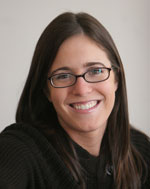Twenty Something / Christina Capecchi
Mapping it out: how to intimately learn Catholicism
 Fifteen years after Richard Louv’s bestseller The Last Child in the Woods was published, it is more relevant than ever. I’m fascinated by his insights on the “nature-deficit disorder” ailing kids.
Fifteen years after Richard Louv’s bestseller The Last Child in the Woods was published, it is more relevant than ever. I’m fascinated by his insights on the “nature-deficit disorder” ailing kids.
I was struck by a passage about his 1950s Midwestern childhood: “I knew my woods and my fields; I knew every bend in the creek and dip in the beaten dirt paths. I wandered those woods even in my dreams.”
His knowledge of that place was so intimate, so vivid that it continued in his dreams, flashing like a movie reel. I want that for my kids, an elixir for the high-tech, low-attention world forming young minds.
Louv sees it the same way. “Nature is reflected in our capacity for wonder,” he wrote.
Shortly after I started reading Louv, I came upon a book that put legs on my yearning. Make Map Art: Creatively Illustrate Your World, written by the sister-brother pair Salli Swindell and Nate Padavick, is a tool kit to turn readers into map makers—complete with compasses, cartouches, legends and landmarks.
Salli and Nate’s line art is folksy and simple. Their lines are not parallel. Their squiggles don’t always connect. The goal is not perfection. It is, in fact, imperfection—evidence that the maps are hand drawn, not computer generated.
A map bursts with old-timey charm. When was the last time you pulled out a map from the glove compartment and used it as a guide?
Salli and Nate’s maps feel nostalgic and whimsical, like an invitation to silence the phone and study nature. Maps “define our place in the world, inspire daydreaming and ignite the wanderlust in all of us,” they wrote. “Maps are about remembering.”
Yes!
Suddenly I was compelled to map out the island that has become our refuge this summer. We have played beneath its gnarled oaks and soaring eagles. We have felt the pulse of the Mississippi River, the island’s clock, setting a pace entirely our own.
Mapping it out tested my knowledge of the island. You cannot map something if you do not know it well. Google Earth provided a helpful reference. Studying the island’s hooks and nooks made me feel like a Girl Scout again.
Just as the doodles can be crooked, the landmarks can be quirky. Salli and Nate call it your “personal geography.” So I marked trees that had meaning to us—“bent oak,” “climber,” “eagles perch”—and delineated the “short cut,” “picnic spot” and “garden.”
Salli and Nate point out that anything can be mapped: future goals, passions, memories of your hometown.
It occurred to me what a rewarding challenge it would be to map out Catholicism. Just as a budding arborist turns to a tree field guide, my reference already exists, a comprehensive summary of our faith: the Catechism of the Catholic Church.
This book gets a bad rap as a stuffy rulebook. But it is poetic and probing, a distillation of salvation history, an introduction to saints and Scripture elegantly curated.
The catechism shines a flashlight on life’s biggest questions. What is a soul? See part 1, section 1, paragraph 33. What is the goal of human existence? Refer to part 3, section 1, paragraph 1719. It is our map of the oldest Christian faith.
My edition is only as tall as my hand, and when I hold it, I feel awe, mindful of the treasures tucked within.
Wouldn’t it be silly to practice Catholicism and miss out on this excellent guide? Wouldn’t it be ungrateful—irresponsible even—to inherit this faith but pass it up before reading its handbook?
To be a good steward—of land or of faith—is to do your homework, to get to know something well. That knowledge paves the way to gratitude and caretaking. And so just as I study the island this summer, cedar by cedar, I’ll be turning over the catechism, stone by stone.
(Christina Capecchi is a writer from Inver Grove Heights, Minn.) †
 Fifteen years after Richard Louv’s bestseller The Last Child in the Woods was published, it is more relevant than ever. I’m fascinated by his insights on the “nature-deficit disorder” ailing kids.
Fifteen years after Richard Louv’s bestseller The Last Child in the Woods was published, it is more relevant than ever. I’m fascinated by his insights on the “nature-deficit disorder” ailing kids.